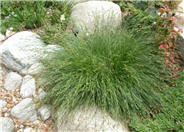
Common name:Blue Lily Turf
Botanical name:Liriope muscari
Grass-like clumps of dark green leaves 1" wide up to 18" long are found on the Liriope muscari. It can reach a height of 12"-15", and dark blue flowers spikes can be seen held above the leaves during the summer. This is an excellent border, accent or ground cover plant that requires part shade exposure.

Common name:Silver Lace Society Garlic
Botanical name:Tulbaghia violacea 'Silver Lace'
This evergreen perennial has 1'-2' long stems with white, margined leaves and rosy/lavender/pink flowers that bloom in spring and summer.

Common name:California Field Sedge
Botanical name:Carex praegracilis
This native Carex can be successfully used as a lawn substitute but requires significant water to obtain good coverage. Once coverage is reached, water can be reduced and maintenance is close to zero. Unmowed, the plant can be used effectively in a variety of conditions and will reach a height of 6" or under and spreads up to 2' by rhizomes.

Common name:Sago-Palm
Botanical name:Cycas revoluta
Sago Palm resembles small palms; it is evergreen. It can slowly grow to 10'. It is used for a tropical effect and also looks great in planters. In the low desert, light shade and additional moisture are best. Side sprouts can form multi-trunked individuals. Apply fertilizer at leaf expansion. This plant has few pests.

Common name:Mediterranean Fan palm
Botanical name:Chamaerops humilis
Slow growing to 20' tall but very hardy, the Mediterranean Fan palm is clump forming with rich green foliage. It can be used as a good container subject. It does best in full sun or partial shade. Petioles have sharp spines.
| Designer: CLWA | Castaic Lake Garden |
Photographer: GardenSoft |
Soils and Compost:
Practice grass-cycling by leaving short grass clippings on lawns after mowing, so that nutrients and organic matter are returned to the soil.
Water Saving Tip:
In general, lawns only need to be watered once every three days.
Check your irrigation controller and reduce watering times if necessary.
Integrated Pest Management:
Attract, or buy beneficial insects such as ladybugs and lacewings to control pest outbreaks in your garden.

